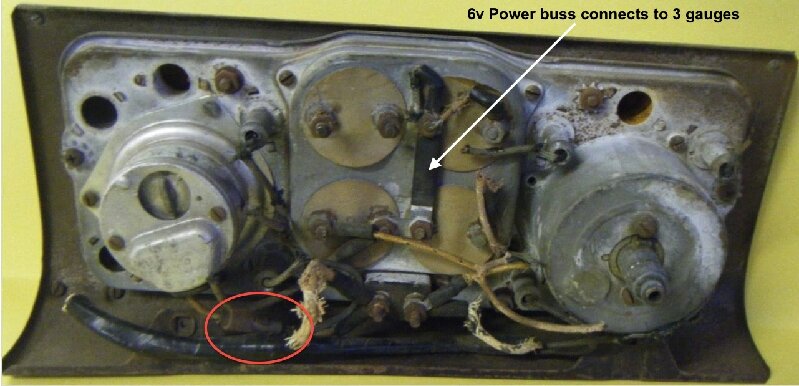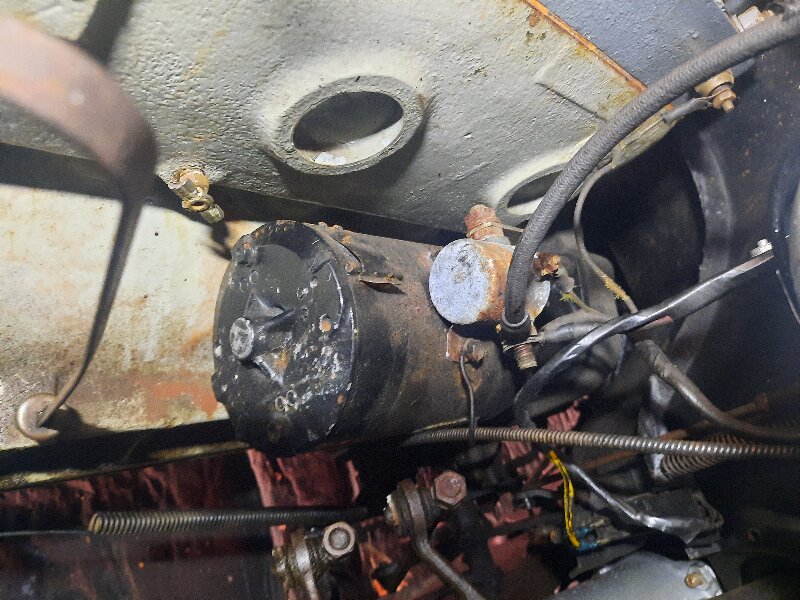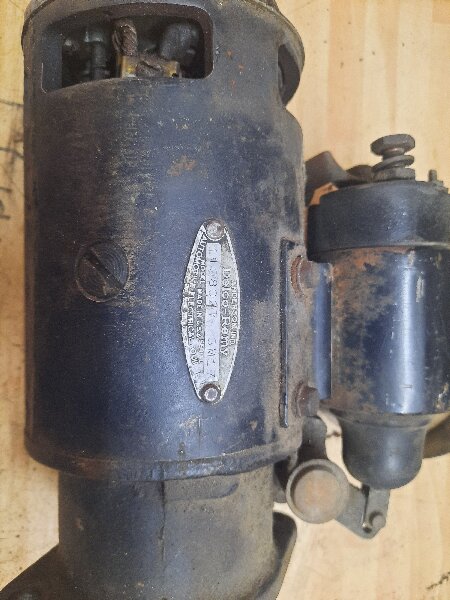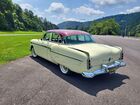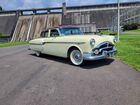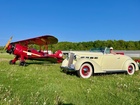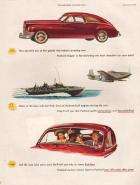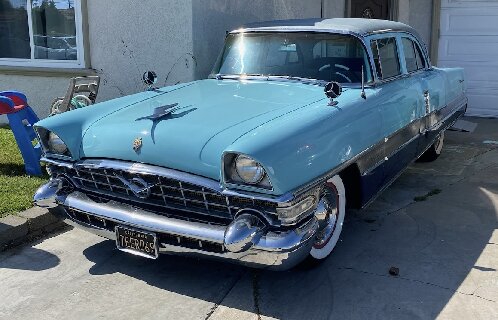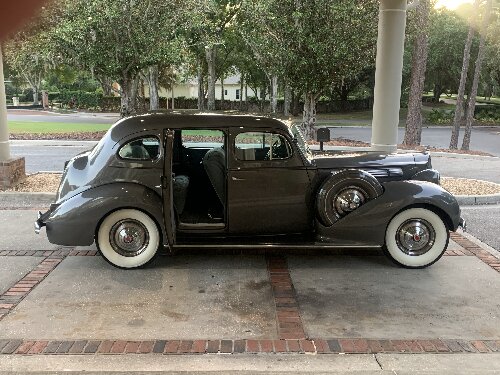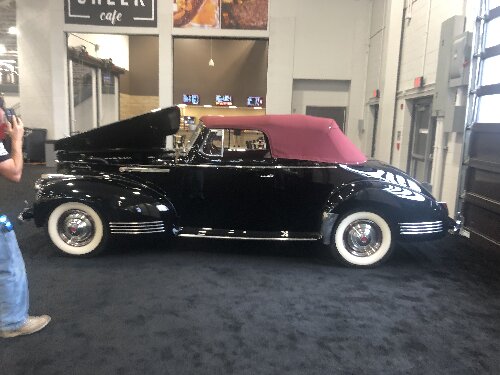|
Re: Mike's 53 Caribbean
|
||||
|---|---|---|---|---|
|
Home away from home
|
If the heads of the bolts are slotted, they are self locking and no washer is required. If otherwise, they get a standard lock washer.
Posted on: 5/4 19:39
|
|||
|
||||
|
Re: 1947 Packard clipper
|
||||
|---|---|---|---|---|
|
Home away from home
|
Short but accurate story/overview: Packard consecutively won the Gallop Poll's Most Beautiful Car in America 1935-37. But their pontoon fendered '38s lost to Buick. Two years later, Packard aped the '38 Buicks' hood louvers in chintzy fashion. Also in 1938, Cadillac's 60 Special Fleetwood, originally intended as the '37 LaSalle, cribbing its thin window frames from the '37 Panhard et Levassor Dynamic, and Lincoln Zephyr's horizontal grille simply as it aided cooling, gave Packard and the industry something to think about. The "Ford-and-a-half's" sideways grille set the industry on a lateral quest, focusing on width, not height, witness the horizontal side grilles on so many '40s automobiles, including your Clipper, Delahaye, and Alfa Romeo.
Packard's small design staff was at an impasse, even sticking 1940's new narrowed grille on a '40 Buick. GM's racy new 1940 C bodies available on all GMobiles save Chevrolet, made Packard's 1938 restyle look staid, shopworn by 1941, when East Grand's traditional bodies were box office poison, while Buick's and Cadillac's hits. Since Packard Darrins were already a well received counter to Lincoln's Continental, East Grand asked Dutch Darrin to render something. He did, and Alex Tremulis, then working for Briggs, and other insiders confirm the Clipper's theme was Darrin's, if adapted by Packard. East Grand's design chief, Werner Gubitz, responsible for Packard's crisp, chiseled look in the '30s, helping Packard look apart from the crowd, enabling the Company to capture 42% of all fine car (above $2,000 FOB) business through '36, and especially Howard Yaeger, even the '33 Pierce-Arrow Silver Arrow's designer, Phil Wright, were involved. They made a few changes: stopping the flow of the front fenders into the front doors, not at the bottom of the rear fenders as Darrin had, and Buick would, in bolt-on fashion, for 1942, decreased the size of Darrin's rear window for a more formal look, small bumps to conceal the vestigal runningboards, and used some GM C body cues. Though introduced April first, 1941, halfway through that model year, and priced between the traditional bodied 120 and 160, the new Clipper outsold the former. Ford's Mustang was also introduced mid-year, in April '64, as a hedge, since that's traditionally when used car inventories at their lowest. Had war not intervened, largely Clipperized 1942 would've been Packards biggest year since 1937, when they whored themselves silly offering the little six--which should've been called something other than Packard-- but after years of Depression worry, who can blame them, and Packard had been offering juniors since late 1905; their Single Six/Six outsold the Eight over five to one through the 1920s. But Packard had never fielded a junior for less than a grand 'til the terrific '35 120, calling in B-O-P production men to help cost the project, even recruiting Chevrolet's sales manager Bill Packer to teach their dealers how to sell credit purchases to the middle class. Packard was already fading, 1929 had been their most profitable year ever, and that was a long time ago. Owning the fine car business through 1936 was moot, since that was a slivver of industry sales. Their 1932-39 Twin Six/Twelve had never been intended as top of the line, only a 376 c.i. FWD V-12 Buick Model 80/90 contender, front wheel drive then the rage, witness Ruxton, Cord L-29, Miller racing cars, and was cheaper to produce than conventional rear wheel drive. But Cadillac, faced with three ton customs, realized a bigger V-8 would bring thermodynamic, balance, cooling woes. So after years of crowing over their V-8, to Packard's chagrin, introduced a straight eight with the firing impulses halved, a V-16, able to use their existing transmission. But with a public seeing more as better, Packard hurriedly stroked the new V-12--similar to Auburn's 391-ci Lycoming V-12 even to the splayed valve layout -- dropping it into the existing Custom 8 chassis, the '32 Twin Six having cooling issues as a result. Pierce Arrow's V-12, with three more main bearings, was designed from the outset as power for massive luxe barouches. However, if using GM's complicated valve silencers under license, while Pierce their patented new hydraulic valve lifters, Packard's Twelve was otherwise nonpareil, thanks to their penchant for over-engineering, quality, refinement, abetted by Gubitz's aforementioned sculpted tailoring, a chassis a trace more modern than Pierce's, certainly than the big archaic Lincolns which nonetheless had the finest craftsmanship of any big domestic, rivaling Rolls-Royce, which England's own respected Laurence Pomeroy dismissed as "a triumph of craftsmanship over engineering." The point of this rainy Saturday afternoon digression, P-49, is to underscore that an already waning Packard was facing a new era preferring smart, rationally sized upscale, thanks to engineering improvements making sheer size look comic opera dated, so survival demanded a coup, the Clipper being Packard's last. Remember, too, that the P-51 Mustang, powered by a Packard-built Rolls-Royce engine, was called "the Cadillac of the skies." Packard's later Ultramatic absorbed war profits merely as GM would not allow Packard to use Hydra-Matic until a year passed after any improvement East Grand made. So the Company conjured, essentially, a Dynaflow with lock up torque convertor, since smoothness was a Packard byword. East Grand's sole major engineering feat of the '50s, Torsion Level, was from an outside engineer after GM and Ford declined, Chrysler having torsion bars at the front only for '57, as Lagonda had in '38 while using after the war, a copy of Packard's prewar Safe-T-Flex i.f.s at the rear -- at the front postwar Rolls-Royce and Bentley. In 1948, Coventry's new Mark V saloon and the XK-120 intended to promote the Mark VII saloon's new engine had front torsion bars. The 1941-47 Clipper abandoned Safe-T-Flex for the same reasons Crewe did 1956 on; cost cutting, and the new, lowered floor pans allowed no room for the long torque arms. Though Packard insiders including John Reinhart wanted to retain and his word, "sweeten" the Clipper, Packard felt pressured by developments of the new envelope bodies postwar, and blew as much of their war profits clobbing 200 lbs. of pork onto the svelte Clipper as an entirely new body would've cost. The same year that sad effort debuted, even as Cadillac, Oldsmobile, Chrysler, even Studebaker about to debut or working on ohv V-8s, Packard, addicted to less hassle, lucrative govt. and jet engine contracts, increasingly phoning in their cars for the sake of largely heartland middle-class conservatives glad to have something called "Packard," bothered only to introduce a pair of new versions of their 1935 One Twenty engine. Good flathead straight eights, certainly. For hobbyists today. Not for the company that once led, not followed, the industry, guided as Packard now was by former GM production managers. For Packard's final new body, East Grand parked a Chevy-based '49 Olds in their styling studio, told John Reinhart and his small crew to use its cowl and roof heights as their guide. Steel cheaper than glass, the "high pockets" result was decried by its skilled designer, John Reinhart, tho' one observer complimented its hood being akin to a Cisatalia, unfortunately offset by what Consumer Reports called "the largest and probably the homeliest grille die casting in the industry." Treasure your Clipper. Packard's ads for it in 1941 alluded to a trio of famed designers, unnamed. Masonic, Detroit Athletic Club, boardroom egos at Packard would hardly admit their company saving bellringer was thanks to a foul-mouthed raconteur and lady's man living in Hollywood. Dutch Darrin had a habit of over-selling, self-aggrandizing. He did not need to do that, anymore than Jelly Roll Morton and Little Richard needed to proclaim they invented jazz and rock 'n' roll. Educated folk, a man, and a woman, driving late model top-rung BMW, and Mercedes, approached me at the gas station, filling my '47 Super Clipper, a Buick Roadmaster according to Packard, asking if it was "a Bentley" or "one of those big Jaguar sedans from the '50s." R-R/Bentley could do no better in their 1956-on Silver Cloud/S-Type than razor edge your Clipper adding the dubious achievement of a curved, one-piece windshield.
Posted on: 5/4 19:10
|
|||
|
||||
|
Re: 48-50 Bimetal Senders Retrofit Project
|
||||
|---|---|---|---|---|
|
Forum Ambassador
|
If you can do without a trim pot and shrink the board to a small enough size you could make something that would mount directly on the two input studs on back of the gauges. Power would then be readily available and with addition of a pigtail to a nearby screw to provide ground, would be self contained. The sender wire could be removed from the original gauge connection and placed on a new terminal on the board with the connection back to the gauge being also used as part of the mounting. Use an easily found and commonly available modern range resistance sender used on many aftermarket gauges such as the almost universal S-W range of 33-240 ohms.
I think you would need some kind of protection on the sender input as all the EMF noise or spikes in the car could easily be picked up by that long unshielded sender lead. If the components are CMOS might also need extra input protection for probable static generated by poor handling when connecting wiring, particularly if working with the sender at the gas tank. Here is the back of a 22-23 cluster that BDeB posted some time ago.
Posted on: 5/4 19:07
|
|||
|
Howard
|
||||
|
||||
|
Re: 48-50 Bimetal Senders Retrofit Project
|
||||
|---|---|---|---|---|
|
Home away from home
|
Quote:
That's true, and not a bad idea. I've used Ardunios many times in the past. And an Arduino Nano has the necessary ADC on it to process an input of variable resistance. The main drawbacks are that it can't be standalone. It needs: - power supply (6-15V to 5V) - precision voltage divider for the input - output driver, since the 20mA per pin of the Arduino is only about 1/25 of what's needed to drive the gauge reading. Also, while programming these is simple enough, it could be a benefit to sell something the user can just set up and trim themselves. Of course you can add some pots to the Arduino but at that point you may as well make a custom daughterboard. And then we should consider an enclosure for it... This really shouldn't be terribly hard with a few op amp circuits combined. Will have to play with it but have been under the weather today, so not been on my PC.
Posted on: 5/4 18:23
|
|||
|
'55 400. Needs aesthetic parts put back on, and electrical system sorted.
'55 Clipper Deluxe. Engine is stuck-ish. |
||||
|
||||
|
Re: Mike's 53 Caribbean
|
||||
|---|---|---|---|---|
|
Home away from home

|
There were no washers on mine at all. Just the bolts. And I don't know that the stater has ever been off before.
New brushes are likely needed. And clean things up a bit. Make sure the battery cables are clean and connections tight. I still had a single click after I rebuilt my starter. Turns out the ground strap at the battery needed to be really tight on the terminal. It was a snug fit but would still be able to wiggle it off with effort. I was taking it off when not in use so as to not drain the battery. Turns out I really had to make it tight fit the connection to be good enough. No problems since then. Kevin
Posted on: 5/4 17:30
|
|||
|
||||
|
Re: 1941 PACKARD 120
|
||||
|---|---|---|---|---|
|
Forum Ambassador
|
In addition to checking the bushings for wear check the long rod ends because the pins that are formed on the end of the rods and go into the bushings are a known wear point. After disassembly some have been found almost worn in half. Also lubricate the levers at the bottom of the steering column. The two levers must be absolutely free to rotate independently on the shaft and there is no provision to properly lubricate the top lever. If the top lever rusts or corrodes or otherwise tries to stick on the shaft it can affect the entire shift action to the point of even locking it up.
When the operator lever is in the relaxed position, a selector tongue is positioned in the upper lever located at the base of the steering column and as you shift gears to second or third that upper lever turns to move the rod that selects second or third gear at the transmission. When the operator lever is pulled back toward the operator the selector tongue moves downward and enters a space in the lower lever so you can select reverse or first. If the upper lever is sticking it moves its rod first and once it moves the interlock in the transmission can prevent reverse or first from being able to be engaged. Here is a photo showing the levers at the base of the column as used in a later year. Your 41 with the exception of the lever shapes and I believe where they are positioned when in neutral will be identical in operation. Place a few drops in the oil hole to get the inner mechanism and lower lever and try to get a few drops to run down the shaft on the outside to get behind the upper lever. If you cannot move the lever to get space for drops of oil below the washer you may need to remove the clip and washer at the top to get a decent amount of oil to flow between the lever and shaft.. Attach file:  shift tube lube copy.jpg (199.13 KB) shift tube lube copy.jpg (199.13 KB)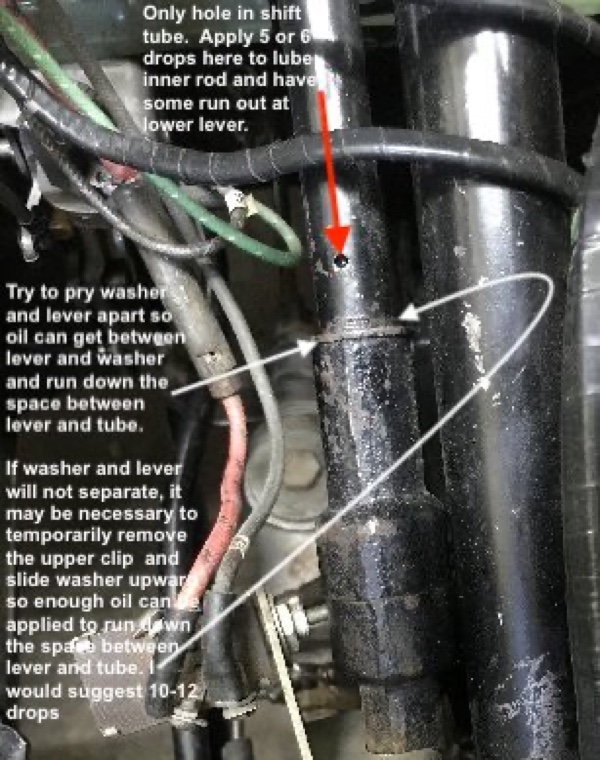
Posted on: 5/4 15:18
|
|||
|
Howard
|
||||
|
||||
|
Re: 1947 Packard clipper
|
||||
|---|---|---|---|---|
|
Home away from home
|
As the story goes, Darrin submitted a design proposal for the new upcoming Clipper line. Supposedly the design or much of it was used, but Packard claimed it as their own. There is a lot more to the design and styling of the 41 - 47 Clippers, and Darrin's claim. Others here with more knowledge will fill in the gaps.
Posted on: 5/4 13:12
|
|||
|
We move toward
And make happen What occupies our mind... (W. Scherer) |
||||
|
||||
|
Re: Mike's 53 Caribbean
|
||||
|---|---|---|---|---|
|
Webmaster
|
Yes, I belive flat washer and lock washer.
Posted on: 5/4 12:54
|
|||
|
-BigKev
1954 Packard Clipper Deluxe Touring Sedan -> Registry | Project Blog 1937 Packard 115-C Convertible Coupe -> Registry | Project Blog |
||||
|
||||
|
Re: Mike's 53 Caribbean
|
||||
|---|---|---|---|---|
|
Home away from home
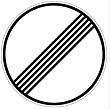
|
Put the clipper in storage for a month, and brought the caribbean home. After one start, the starter would only click on the Caribbean. I am putting in a spare starter and would like to know, are there supposed to be any washers under the Heads of the two bolts that hold the starter to the bellhousing? My car has none, but not sure if there should be any lock or normal washers.
I think the one starter is from a 54. I cleaned all the contacts and bench tested it. Hope it works and I can rebuild the one I have removed.
Posted on: 5/4 12:47
|
|||
|
1953 Clipper Delux Club Sedan, 1953 Caribbean, 1969 912, 1990 Miata
|
||||
|
||||

